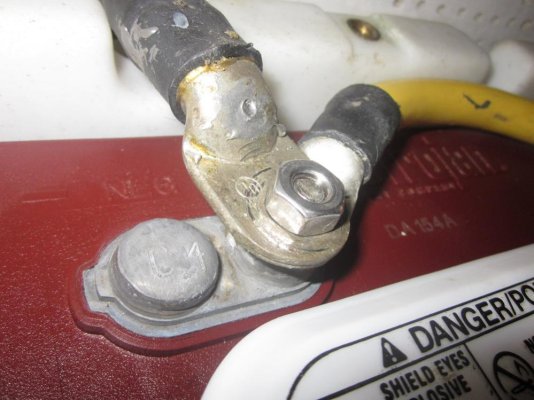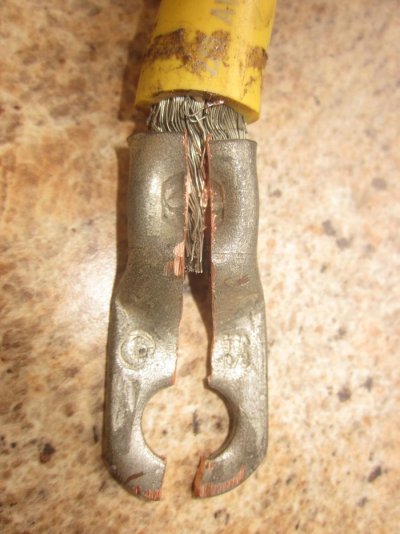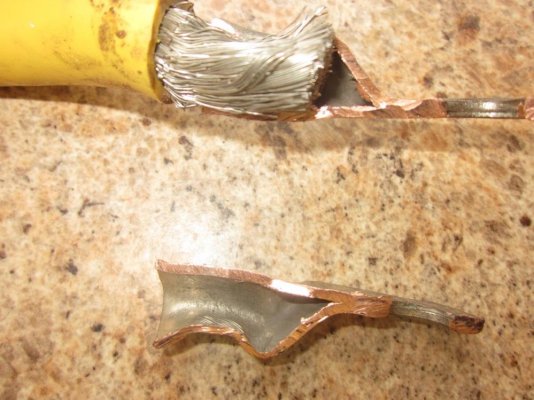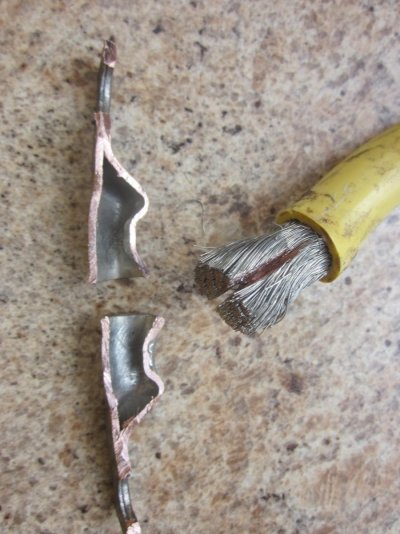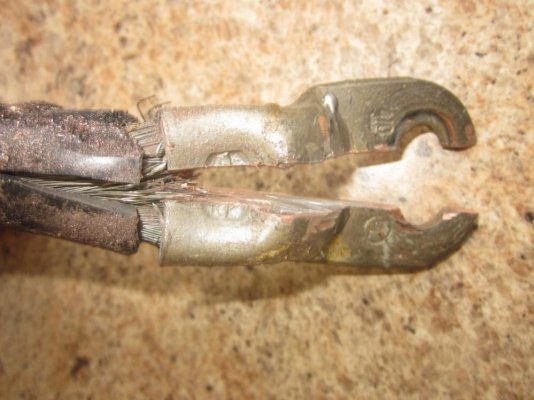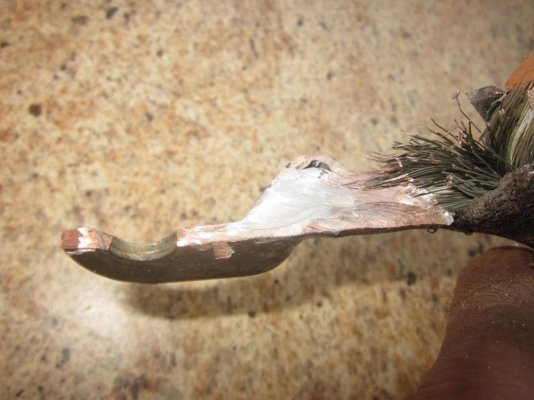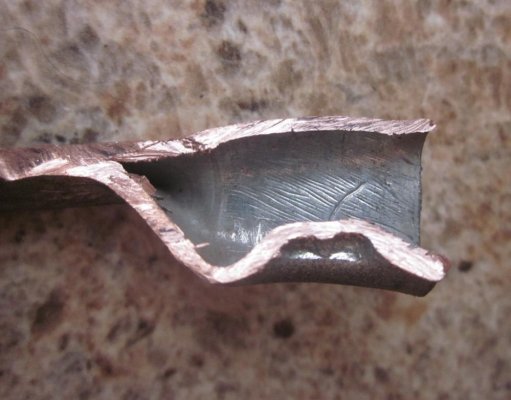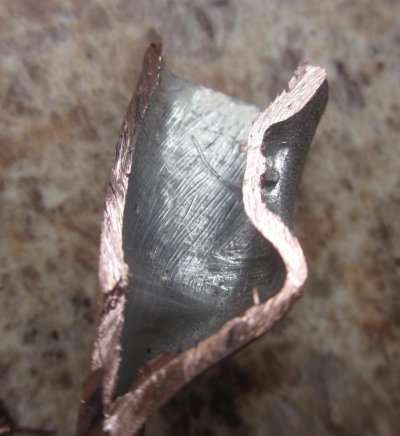You are using an out of date browser. It may not display this or other websites correctly.
You should upgrade or use an alternative browser.
You should upgrade or use an alternative browser.
Solder or Crimp
- Thread starter timjet
- Start date
The friendliest place on the web for anyone who enjoys boating.
If you have answers, please help by responding to the unanswered posts.
If you have answers, please help by responding to the unanswered posts.
High Wire
Guru
Tom.B
Moderator Emeritus
- Joined
- Jul 30, 2009
- Messages
- 5,839
- Location
- USA
- Vessel Name
- Skinny Dippin'
- Vessel Make
- Navigator 4200 Classic
After seeing this write-up, that's the crimping tool I decided to go with. $250, but I was redoing my entire DC system, so I saw the value in it. It makes amazing crimps (with the correct lugs). Any TF member in the NC area that want to borrow it, I would gladly let you.
Still, on-topic, I have heard people the do use solder to fill lugs post-crimp. I won't. A good crimp doesn't need it.
Shoalwaters
Guru
- Joined
- Feb 24, 2008
- Messages
- 681
- Location
- St. Lucia, West Indies
- Vessel Name
- "Dragon Lady"
- Vessel Make
- DeFever 41
I think that methods of attaching lugs to heavy cables has been fairly well covered.
A plug here (pun intended) for the use of heat-shrink/glue type terminals and butt-joints on lighter wires - say AWG #10 and smaller. In addition to sealing out moisture, the heat-shrink part provides a useful mechanical connection between wire and terminal. IMHO this significantly reduces the possibility of a wire pulling out of its crimp or breaking due flexure at the crimped joint.
A plug here (pun intended) for the use of heat-shrink/glue type terminals and butt-joints on lighter wires - say AWG #10 and smaller. In addition to sealing out moisture, the heat-shrink part provides a useful mechanical connection between wire and terminal. IMHO this significantly reduces the possibility of a wire pulling out of its crimp or breaking due flexure at the crimped joint.
Attachments
C lectric
Guru
CRIMP.
Then if you still want to solder, do it after but it shouldn't be neccesary.
I have made crimps with one of the hammer tools quite successfully.
BUT
you need a small sledge of about 3 pounds and the crimper must be on something solid or it will simply bounce producing a poor crimp and maybe flinging the partly collapsed and now useless lug somewhere.
I have a steel plate of about 10 lb that seems to be ok but I still prefer to find some heavy steel work on the docks or take it up to land.
You will hear the tone change when the crimp is solid.
Otherwise use a decent crimper from a battery shop. My local chandler has one of the FTX crimpers for loan if you buy the lugs and wire from him.
I have a H.D.crimper but may also borrow the chandlers crimper when I make some long cables which have to be threaded into place before terminating.
Then if you still want to solder, do it after but it shouldn't be neccesary.
I have made crimps with one of the hammer tools quite successfully.
BUT
you need a small sledge of about 3 pounds and the crimper must be on something solid or it will simply bounce producing a poor crimp and maybe flinging the partly collapsed and now useless lug somewhere.
I have a steel plate of about 10 lb that seems to be ok but I still prefer to find some heavy steel work on the docks or take it up to land.
You will hear the tone change when the crimp is solid.
Otherwise use a decent crimper from a battery shop. My local chandler has one of the FTX crimpers for loan if you buy the lugs and wire from him.
I have a H.D.crimper but may also borrow the chandlers crimper when I make some long cables which have to be threaded into place before terminating.
FF
Guru
- Joined
- Oct 12, 2007
- Messages
- 22,552
The problem with crimping is the pressure must be high enough to cold flow the solder.
This is the electrical part of the requirement , not the mechanical.
Normally a good pro (expen$ive) tool is required.
I prefer to use BOTH , so I do solder the terminal ends after crimping..
The goal is to melt the solder IN the fitting , but not up that nice pricy flexible tinned wire.
My method is a BIG copper roofing iron (its really copper) well heated with a torch.
Think of it as a BTU battery that can deliver 5 min of torch heating in seconds of contact.
Practice on one fitting ,contact just enough time to melt a thin solder wire held at the insertion end .
Then cut it open and see if solder is solid in the fitting is solid , and the cable still flexible outside the fitting.
It is usually easiest to do all the soldering at one time after everything is made up to size.
Then use the 3X shrink tubing (color code counts) to finish.
This is the electrical part of the requirement , not the mechanical.
Normally a good pro (expen$ive) tool is required.
I prefer to use BOTH , so I do solder the terminal ends after crimping..
The goal is to melt the solder IN the fitting , but not up that nice pricy flexible tinned wire.
My method is a BIG copper roofing iron (its really copper) well heated with a torch.
Think of it as a BTU battery that can deliver 5 min of torch heating in seconds of contact.
Practice on one fitting ,contact just enough time to melt a thin solder wire held at the insertion end .
Then cut it open and see if solder is solid in the fitting is solid , and the cable still flexible outside the fitting.
It is usually easiest to do all the soldering at one time after everything is made up to size.
Then use the 3X shrink tubing (color code counts) to finish.
bligh
Guru
I,m a fan of a good soldered joint myselfView attachment 29119View attachment 29120View attachment 29121
Jukes, that looks awesome. What is your method of removing the flux from inside the stranded wire above the solder joint?? Do you soak the cable in hot water after you solder the cables? Or is there a better method?
jukesy
Senior Member
- Joined
- Mar 10, 2013
- Messages
- 267
- Vessel Name
- LUCKY US
- Vessel Make
- American Tug
Thanks Bligh. Yeah pretty much. I have a squirt bottle of hot soapy water and then a blast of air from the compressor before I wrap them in coloured electrical tape.
Hope your enjoying you NT.
Cheers
Hope your enjoying you NT.
Cheers
Cathy and David
Veteran Member
Klein Tools
Here is a link to a crimper made by Klein Tools the gold standard for electrical trade tooling. It is good for lugs up to 4/0 in size.
KLEIN TOOLS Battery Terminal Crimper,6-4/0 AWG - Cable and Wire Crimping Tools - 25D147|2006 - Grainger Industrial Supply
Here is a link to a crimper made by Klein Tools the gold standard for electrical trade tooling. It is good for lugs up to 4/0 in size.
KLEIN TOOLS Battery Terminal Crimper,6-4/0 AWG - Cable and Wire Crimping Tools - 25D147|2006 - Grainger Industrial Supply
Cathy and David
Veteran Member
Have to Weigh In
I have to add my 2 cents to the debate. A mechanical crimp performed with a proper tool is a much more effective bond to the lug than a soldered joint. In my 30+ years in the trade I performed very few soldered joints and they were only because the electrical device required it. They were 60A and above special plugs where the only choice was a soldered joint. All other joints were with high pressure crimp tools that were either hydraulic or old fashioned hand operated. There are too many variables that need to be perfect to achieve a reliable soldered joint.
As far as heat shrink if it makes you feel better go for it but it will not prevent corrosion. Have you ever seen a corroded battery cable where the insulation looks perfect but the wire is corroded 2' past the lug. The best protection against corrosion and oxidation is Nolox applied to the wire before the crimp.
The lugs that I have seen pictured on the thread are mechanical crimp lugs. A lug intended for a soldered joint will be oversized to the wire gauge so that you get a good bond and complete solder flow through the wire strands.
Just my 2 cents to the discussion.
I have to add my 2 cents to the debate. A mechanical crimp performed with a proper tool is a much more effective bond to the lug than a soldered joint. In my 30+ years in the trade I performed very few soldered joints and they were only because the electrical device required it. They were 60A and above special plugs where the only choice was a soldered joint. All other joints were with high pressure crimp tools that were either hydraulic or old fashioned hand operated. There are too many variables that need to be perfect to achieve a reliable soldered joint.
As far as heat shrink if it makes you feel better go for it but it will not prevent corrosion. Have you ever seen a corroded battery cable where the insulation looks perfect but the wire is corroded 2' past the lug. The best protection against corrosion and oxidation is Nolox applied to the wire before the crimp.
The lugs that I have seen pictured on the thread are mechanical crimp lugs. A lug intended for a soldered joint will be oversized to the wire gauge so that you get a good bond and complete solder flow through the wire strands.
Just my 2 cents to the discussion.
caltexflanc
Guru
I have to add my 2 cents to the debate. A mechanical crimp performed with a proper tool is a much more effective bond to the lug than a soldered joint. In my 30+ years in the trade I performed very few soldered joints and they were only because the electrical device required it. They were 60A and above special plugs where the only choice was a soldered joint. All other joints were with high pressure crimp tools that were either hydraulic or old fashioned hand operated. There are too many variables that need to be perfect to achieve a reliable soldered joint.
As far as heat shrink if it makes you feel better go for it but it will not prevent corrosion. Have you ever seen a corroded battery cable where the insulation looks perfect but the wire is corroded 2' past the lug. The best protection against corrosion and oxidation is Nolox applied to the wire before the crimp.
The lugs that I have seen pictured on the thread are mechanical crimp lugs. A lug intended for a soldered joint will be oversized to the wire gauge so that you get a good bond and complete solder flow through the wire strands.
Just my 2 cents to the discussion.
Good post, but I disagree a bit about heat shrink. Standard heat shrink, I do tend to agree, but properly applied adhesive lined shrink, absolutely not.
I have a squirt bottle of hot soapy water and then a blast of air from the compressor before I wrap them in coloured electrical tape.
Electrical tape??!! Ay yi yi!
FF
Guru
- Joined
- Oct 12, 2007
- Messages
- 22,552
>The best protection against corrosion and oxidation is Nolox applied to the wire before the crimp.<
Perhaps but ,
The folks with the most to loose from corrosion is the telephone guys.
THIN!!! wires and corrosion is noise complaints.
AS they were frequently at my marina (before free cell phones) they had capsules of Bell Tell goop to shmeer on terminals and wire connections.
Free as it was not an inventoried item , and the wiring done with both crimp and solder covered with a shmeer and then heat shrunk are still good after 30 years.
This was done After the terminal end was crimped and soldered.
Perhaps but ,
The folks with the most to loose from corrosion is the telephone guys.
THIN!!! wires and corrosion is noise complaints.
AS they were frequently at my marina (before free cell phones) they had capsules of Bell Tell goop to shmeer on terminals and wire connections.
Free as it was not an inventoried item , and the wiring done with both crimp and solder covered with a shmeer and then heat shrunk are still good after 30 years.
This was done After the terminal end was crimped and soldered.
JDCAVE
Guru
- Joined
- Apr 3, 2011
- Messages
- 2,902
- Location
- Canada
- Vessel Name
- Phoenix Hunter
- Vessel Make
- Kadey Krogen 42 (1985)
At $270 for a battery terminal crimper, it sounds like its best to see you neighbourhood mechanic (or in my case shipwright) to borrow said tool for the rare times you need one!
Jim, Sent from my iPad using Trawler
Jim, Sent from my iPad using Trawler
Shoalwaters
Guru
- Joined
- Feb 24, 2008
- Messages
- 681
- Location
- St. Lucia, West Indies
- Vessel Name
- "Dragon Lady"
- Vessel Make
- DeFever 41
> . . the telephone guys . . . had capsules of Bell Tell goop to shmeer on terminals and wire connections. . . . the wiring done with both crimp and solder covered with a shmeer and then heat shrunk are still good after 30 years.
Sounds interesting. Where can ordinary mortals buy this stuff?
When I installed the new inverter/charger, I drilled a small hole, after crimping and then filled the void with solder, then finished with heat shrink. Here's the 4/0 negative from the inverter/charger with the 2/0 battery interconnects.
Here are pictures of solder and no solder lugs. I was reconfiguring our inverter that I had installed 6.5 years ago and pulled these 2 cables.
The yellow 2/0 and black 4/0 were crimped with the same tool just different size dies. I cut off the heat shrink (I cut to deep on the black) then cut each lug. The 4/0 lug sure became one.
Attachments
Nice. Thanks!
Sent from my iPad using Trawler Forum
Bay Pelican
Moderator Emeritus
Suggest crimping is the normal procedure. If you are looking ahead to a few years of boating, especially if you plan to anchor out, suggest you look at a $150 crimper. Can't think of the name of the model I bought but I use it about once a year.
caltexflanc
Guru
Got around to reading the Compass Marine link, I knew it would be pretty good based on his other writings I've seen, and it is! Explains why all crimps are not created equal!
Capt.Bill11
Guru
Rwidman, I respectfully disagree. I have used this practice for well over 20 years- professionally, and all of the cables on Patricia Louise are assembled this way. I now own the big buck crimpers, but have never had a solder "failure". Does this mean I win the debate
!!
1983 Present 42 Sundeck
Lehman 135 Twins
Did you continue to heat the lug after you inserted the cable end? If not then I agree with Ron. I don't see how you can get a proper soldered connection by only heating one of the two pieces you are soldering together while dipping the cold piece into hot solder.
caltexflanc
Guru
Bill: here's a video:
http://www.delcity.net/documents/movies/battery_terminals.mpg
And the written instructions:
http://www.delcity.net/documents/instructions/battery_solder_slug_install_instructions.jsp
http://www.delcity.net/documents/movies/battery_terminals.mpg
And the written instructions:
http://www.delcity.net/documents/instructions/battery_solder_slug_install_instructions.jsp
Last edited:
Capt.Bill11
Guru
Thanks George. I've used that method before. And as you see #8 mentions continuing to heat the terminal after you insert the wire. It's just the poster did not so I was wondering if he left out that step in how he makes his connections or just in his description of how he makes them. 
There is third option as well for battery terminals. And that is the 2 piece kind that screw together.
screw together battery ends - Google Search
There is third option as well for battery terminals. And that is the 2 piece kind that screw together.
screw together battery ends - Google Search
Forkliftt
Guru
- Joined
- Oct 6, 2007
- Messages
- 2,450
- Location
- USA
- Vessel Name
- KnotDoneYet
- Vessel Make
- 1983 42' Present Sundeck
Did you continue to heat the lug after you inserted the cable end? If not then I agree with Ron. I don't see how you can get a proper soldered connection by only heating one of the two pieces you are soldering together while dipping the cold piece into hot solder.
Cap'n Bill 11
No, I didn't heat it afterwards. There was no need. Turns out the cable gets very hot when dipped into boiling solder and then it all cools together. I cut a soldered terminal end apart to compare it to the recently posted crimped terminal series of posts. But after making the cut- turns out I couldn't got the wire out of the terminal to snap a picture of?.....
1983 Present 42 Sundeck
Lehman 135 Twins
caltexflanc
Guru
Cap'n Bill 11
No, I didn't heat it afterwards. There was no need. Turns out the cable gets very hot when dipped into boiling solder and then it all cools together. I cut a soldered terminal end apart to compare it to the recently posted crimped terminal series of posts. But after making the cut- turns out I couldn't got the wire out of the terminal to snap a picture of?.....
1983 Present 42 Sundeck
Lehman 135 Twins
Those were really horrid, "dimple" crimps in those pictures. And poor terminals too. See the link someone posted to the Compass Marine "how to" tutorial.
Capt.Bill11
Guru
Cap'n Bill 11
No, I didn't heat it afterwards. There was no need. Turns out the cable gets very hot when dipped into boiling solder and then it all cools together. I cut a soldered terminal end apart to compare it to the recently posted crimped terminal series of posts. But after making the cut- turns out I couldn't got the wire out of the terminal to snap a picture of?.....
1983 Present 42 Sundeck
Lehman 135 Twins
Sorry, but you are going to have a hard time convincing me that a large cable could get hot enough when just dipped into hot solder with no added heat applied to form a proper soldered connection. Wire is a good conductor of heat, hence I would think it would carry away much of the residual heat in the solder. So while I can see how the tip of the wires and some of the outer strands may bond with the solder, I don't see how with out the wires being heated much of the solder could wick up into the strands as it should in a good solder connection. Unless perhaps the cable end was tinned with solder before hand.
In the terminal you cut apart how far up had the wire strands had the solder migrated?
- Joined
- Apr 15, 2008
- Messages
- 13,731
- Location
- California Delta
- Vessel Name
- FlyWright
- Vessel Make
- 1977 Marshall Californian 34 LRC
If I understand the issue correctly, the question is between 2 options:
1. Crimp only
or
2. Crimp and solder
No one is suggesting to solder only, right? (no mechanical bond)
So to me the bottom line is, "Does soldering a crimped connection improve or harm its electrical conductivity and resistance to the negative effects of corrosion?"
Personally, I have only crimped with shrink wrap...no soldering. After consulting aviation avionics technicians with decades of experience, they confirmed this to me. To demonstrate it, they showed me the connections on a 1500A ground power unit used to assist on aircraft power-up and jet engine starts. All the connections were crimped only. Of course, the cable was the highest quality fine-strand cable.
1. Crimp only
or
2. Crimp and solder
No one is suggesting to solder only, right? (no mechanical bond)
So to me the bottom line is, "Does soldering a crimped connection improve or harm its electrical conductivity and resistance to the negative effects of corrosion?"
Personally, I have only crimped with shrink wrap...no soldering. After consulting aviation avionics technicians with decades of experience, they confirmed this to me. To demonstrate it, they showed me the connections on a 1500A ground power unit used to assist on aircraft power-up and jet engine starts. All the connections were crimped only. Of course, the cable was the highest quality fine-strand cable.
Capt.Bill11
Guru
No one is suggesting to solder only, right? (no mechanical bond)
No, some have mentioned soldering only. But a properly crimped and sealed connection is probably the way to go in the long run.
caltexflanc
Guru
ABYC allows the soldering-only method such as I linked to, for battery cables
"11.16.3.7. Solder shall not be the sole means of mechanical connection in any circuit. If soldered, the connection shall be so located or supported as to minimize flexing of the conductor where the solder changes the flexible conductor into a solid conductor.
EXCEPTION: Battery lugs with a solder contact length of not less than 1.5 times the diameter of the conductor.
NOTE: When a stranded conductor is soldered, the soldered portion of the conductor becomes a solid strand conductor, and flexing can cause the conductor to break at the end of the solder joint unless adequate additional support is provided."
That points up why it is important to use the right terminals. I don't see why one would pick the solder method if access to a good crimper is available. The labor cost of having a proficient shop make the cables up for you is minimal.
"11.16.3.7. Solder shall not be the sole means of mechanical connection in any circuit. If soldered, the connection shall be so located or supported as to minimize flexing of the conductor where the solder changes the flexible conductor into a solid conductor.
EXCEPTION: Battery lugs with a solder contact length of not less than 1.5 times the diameter of the conductor.
NOTE: When a stranded conductor is soldered, the soldered portion of the conductor becomes a solid strand conductor, and flexing can cause the conductor to break at the end of the solder joint unless adequate additional support is provided."
That points up why it is important to use the right terminals. I don't see why one would pick the solder method if access to a good crimper is available. The labor cost of having a proficient shop make the cables up for you is minimal.
FF
Guru
- Joined
- Oct 12, 2007
- Messages
- 22,552
When I have seen big terminal ends dipped in solder , it was usually by using a plumbers lead melting pot (from when lead was poured into cast iron waste lines) screwed on top of a 20# propane tank.
These would contain multiple sticks of solder and be perhaps 20 lbs of boiling solder.
Normal was sticking a terminal end (they usually used FAT welding cable) in the pot for 15 seconds would cool it off.
Trawlers (real) and draggers would not spring for tinned wire , tho they would crimp before the hot solder dunk.
These would contain multiple sticks of solder and be perhaps 20 lbs of boiling solder.
Normal was sticking a terminal end (they usually used FAT welding cable) in the pot for 15 seconds would cool it off.
Trawlers (real) and draggers would not spring for tinned wire , tho they would crimp before the hot solder dunk.
Last edited:
Similar threads
- Replies
- 53
- Views
- 3K
- Replies
- 1
- Views
- 592
- Replies
- 1
- Views
- 366
- Replies
- 36
- Views
- 4K
- Replies
- 32
- Views
- 2K



